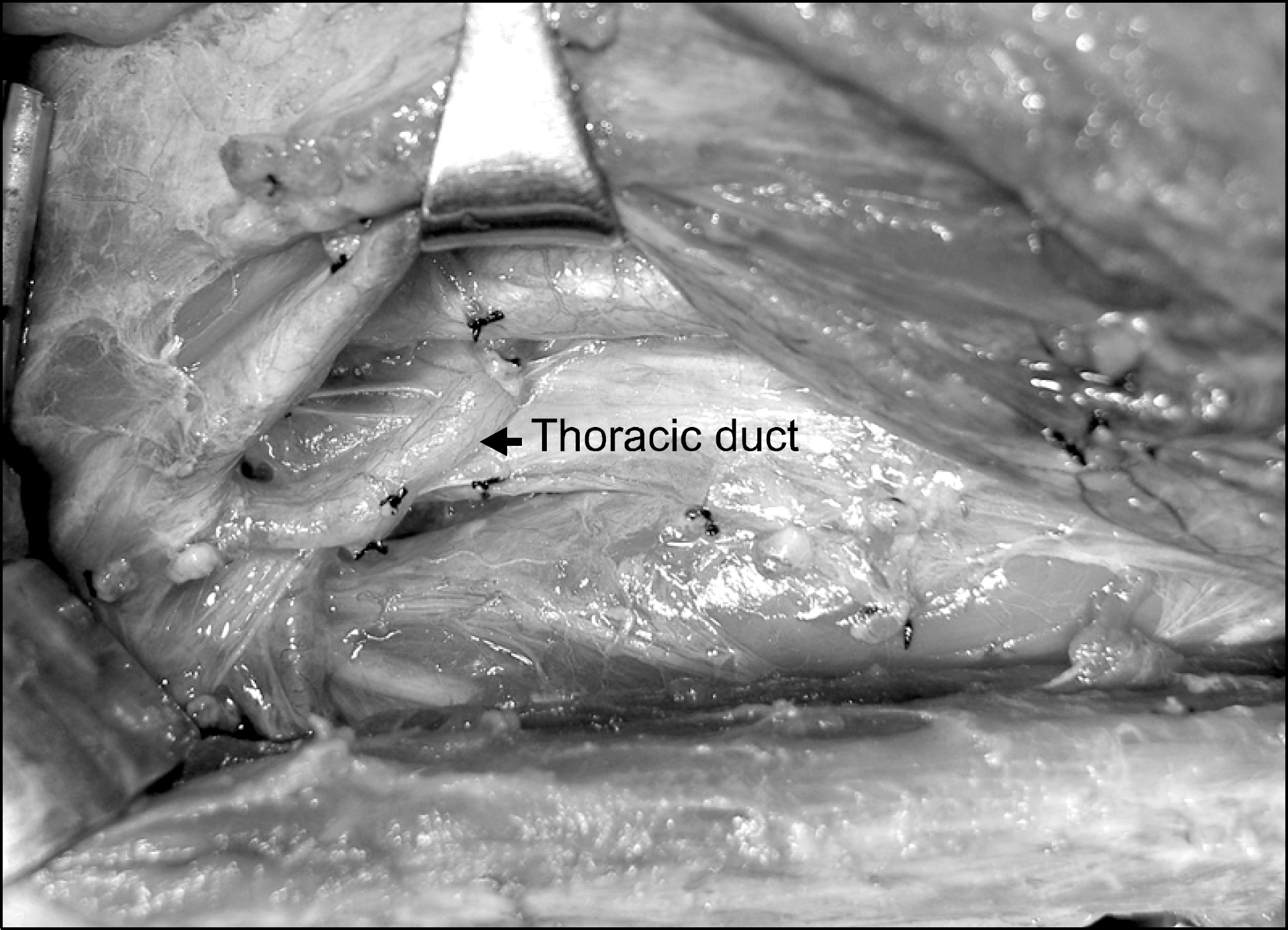Abstract
Purpose:
The typical complications after thyroidectomy are bleeding, hematoma, hoarseness, hypocalcemia, chylous fistula, etc. The aim of this study was to determine the incidence and to evaluate risk factors of complication after total thyroidectomy and lymph node dissection (ND) for thyroid cancer.
Methods:
We performed a retrospective review of 623 patients with thyroid cancer and who underwent total thyroidectomy and ND and the patients were treated at our hospital from March 2007 to February 2010. The clinical features of complications were reviewed and the incidence and predisposing factors of the complication were analyzed.
Results:
Postoperative bleeding occurred in 0.2% of the patients. The overall incidence of transient and permanent hypocalcemia was 8.5% and 0.6%, respectively. Graves disease, a decreased number of preserved parathyroid glands and an increased number of removed central lymph nodes constituted the risk factors for postoperative hypocalcemia. On multivariate logistic regression analysis, the presence of Graves disease and a decreased number of preserved parathyroid glands were the independent risk factors for postoperative hypocalcemia. Hoarseness occurred in 1.6% of the patients. The incidence of chylous fistula after lymph node dissection in the central neck and lateral neck was 0.5% and 0.3%, respectively.
Conclusion:
Total thyroidectomy with ND is a safe procedure because the overall incidence of postoperative complications is low. Careful surgery is required for thyroid cancer patients with Graves disease. Parathyroid gland insufficiency is the important cause of hypocalcemia after to-tal thyroidectomy and ND. To reduce voice change, careful dissection is required around the recurrent laryngeal nerve and excessive tracheal traction should be avoided.
Go to : 
REFERENCES
1.Shaha AR., Jaffe BM. Parathyroid preservation during thyroid surgery. Am J Otolaryngol. 1998. 19:113–7.

2.Cheah WK., Arici C., Ituarte PH., Siperstein AE., Duh QY., Clark OH. Complications of neck dissection for thyroid cancer. World J Surg. 2002. 26:1013–6.

3.Thomusch O., Machens A., Sekulla C., Ukkat J., Brauckhoff M., Dralle H. The impact of surgical technique on postoperative hypoparathyroidism in bilateral thyroid surgery: a multivariate analysis of 5846 consecutive patients. Surgery. 2003. 133:180–5.

4.McHenry CR., Speroff T., Wentworth D., Murphy T. Risk factors for postthyroidectomy hypocalcemia. Surgery. 1994. 116:641–7.
5.Demeester-Mirkine N., Hooghe L., Van Geertruyden J., De Maertelaer V. Hypocalcemia after thyroidectomy. Arch Surg. 1992. 127:854–8.

6.Kark AE., Kissin MW., Auerbach R., Meikle M. Voice changes after thyroidectomy: role of the external laryngeal nerve. Br Med J (Clin Res Ed). 1984. 289:1412–5.

7.Crumley RL., Smith JD. Postoperative chylous fistula prevention and management. Laryngoscope. 1976. 86:804–13.

8.de Gier HH., Balm AJ., Bruning PF., Gregor RT., Hilgers FJ. Systematic approach to the treatment of chylous leakage after neck dissection. Head Neck. 1996. 18:347–51.

9.Park JD., Hong SJ. Chylous fistula after surgery for papillary thyroid carcinoma. Korean J Endocrine Surg. 2002. 02:109–15.

10.Shaha AR., Jaffe BM. Practical management of post-thyroidectomy hematoma. J Surg Oncol. 1994. 57:235–8.

11.Godballe C., Madsen AR., Pedersen HB., Sørensen CH., Pedersen U., Frisch T, et al. Post-thyroidectomy hemorrhage: a national study of patients treated at the Danish departments of ENT Head and Neck Surgery. Eur Arch Otorhinolaryngol. 2009. 266:1945–52.

12.Farrar WB., Cooperman M., James AG. Surgical management of papillary and follicular carcinoma of the thyroid. Ann Surg. 1980. 192:701–4.

13.Wingert DJ., Friesen SR., Iliopoulos JI., Pierce GE., Thomas JH., Hermreck AS. Post-thyroidectomy hypocalcemia. Incidence and risk factors. Am J Surg. 1986. 152:606–10.
14.Attie JN., Moskowitz GW., Margouleff D., Levy LM. Feasibility of total thyroidectomy in the treatment of thyroid carcinoma: postoperative radioactive iodine evaluation of 140 cases. Am J Surg. 1979. 138:555–60.
15.Lal G., Ituarte P., Kebebew E., Siperstein A., Duh QY., Clark OH. Should total thyroidectomy become the preferred procedure for surgical management of Graves' disease? Thyroid. 2005. 15:569–74.

16.Pesce CE., Shiue Z., Tsai HL., Umbricht CB., Tufano RP., Dackiw AP, et al. Postoperative hypocalcemia after thyroidectomy for Graves' disease. Thyroid. 2010. 20:1279–83.

17.Attie JN., Khafif RA. Preservation of parathyroid glands during total thyroidectomy. Improved technic utilizing microsurgery. Am J Surg. 1975. 130:399–404.
18.Horsley J. Suture of the recurrent laryngeal nerve with report of a case. Trans South Surg Gynecol Assoc. 1909. 22:161–7.

20.Thawley SE. "How I do it"–head and neck. A targeted problem and its solution. Chylous fistula prevention and management. Laryngoscope. 1980. 90:522–5.
21.Mallen RW., Kudryk WH. Case report: Chylous fistula following right radical neck dissection. Can J Otolaryngol. 1975. 4:177–9.
Go to : 
Table 1.
Clinicopathologic characteristics of the patients
Table 2.
Clinical features and incidences of complication after total thyroidectomy and lymph node dissection
Table 3.
Univariate analysis of clinicopathologic characteristics in postoperative hypocalcemia
Table 4.
Multivariate analysis of clinicopathologic characteristics in postoperative hypocalcemia




 PDF
PDF ePub
ePub Citation
Citation Print
Print




 XML Download
XML Download